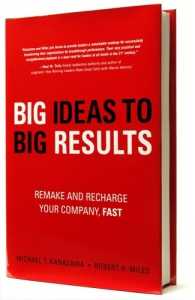Many organizations reach a point in their existence when they hit a plateau or begin to stagnate. When that happens, they often seek a "breakthrough" in their performance. Sometimes, they succeed and sometimes they don't.
 I recently read "Big Ideas to Big Results," by Michael Kanazawa and Robert Miles, which is all about increasing your chance of success when you're seeking to re-vitalize your company. This book had a unique attraction for me, since I worked with Mike and Bob on one of the transformations they discuss in the book (it was called "Taking Charge" and is referred to at various points throughout the book, but specifically summarized on page 118 & 119).
I recently read "Big Ideas to Big Results," by Michael Kanazawa and Robert Miles, which is all about increasing your chance of success when you're seeking to re-vitalize your company. This book had a unique attraction for me, since I worked with Mike and Bob on one of the transformations they discuss in the book (it was called "Taking Charge" and is referred to at various points throughout the book, but specifically summarized on page 118 & 119).
The authors have worked together on a number of corporate transformations, and they share their experiences to help us minimize the chances that we'll run the "typical" course: some lame, corporate feelgood program that achieves nothing. I've been there and it is not a fun fate.
Beware of zombies
The authors do a nice job of keeping things interesting by telling colorful stories to illustrate their points. One I enjoyed is Michael Kanazawa's discussion of "Zombie Projects" which he encountered, ironically, while working in the same area as Dilbert's creator Scott Adams.
"Zombie projects had supposedly been killed through inattention or lack of formal funding, but, in fact, they continued to live on as pet projects of key manager who couldn't or wouldn't let go."
These kinds of projects suck resources and motivation from the rest of the organization, causing "drag" on the business. The authors discuss the reasons these projects are allowed to exist and most of the book deals with how to ferret out and get rid of these kinds of useless activities.
Set the right drumbeat
Another interesting topic covered in the book deals with how leaders can make or break their team's success through the "drumbeat" they establish. Examples of leaders who to force too much "sense of urgency," which often has the opposite effect; rather than getting people to work harder or faster, their "urgency" shuts down debate and makes people feel anxious or frustrated.
They offer some powerful tips for how to manage your team's "sense of time" so that people use their times productively, without panic, and without feeling like they'll slow down progress by injecting their opinions or challenging things that are happening.
Engage the masses
One of the things that comes out strongly in the book (and one of the most memorable aspects of the Taking Charge project I was part of) is that the authors have developed a true methodology for engaging people across a company and focusing them on a specific set of outcomes. Their construct called "Tablework" is a big part of encouraging innovative thinking and microcollaboration among small teams, which is then reconnected back into the company's larger objectives.
Perhaps the most powerful aspect of their approach is the drive to create "leaders at all levels" - crucial in creating a self-sustaining, effective business that can scale. A big part of that is letting people throughout the organization own various aspects of strategy and execution - and holding them accountable.
But one other vital aspect of this is making sure people feel recognized for their part in the company's success, and helping them discern the difference between things they must do and things they must strive for. They present the latter using a concept I really love - the distinction between "promises" (absolute goals) and "declarations" (a statement of intent when the means to get there are unknown).
Get big
This book is jam packed with information and techniques, but is fun to read. I also believe it can be a handy recipe book to help managers and leaders deal with specific problem areas, even if you don't go through the whole transformation process form end-to-end.
If you're a leader looking to drive your business out of the "same old same old" then I highly recommend Big Ideas to Big Results.
Related items
